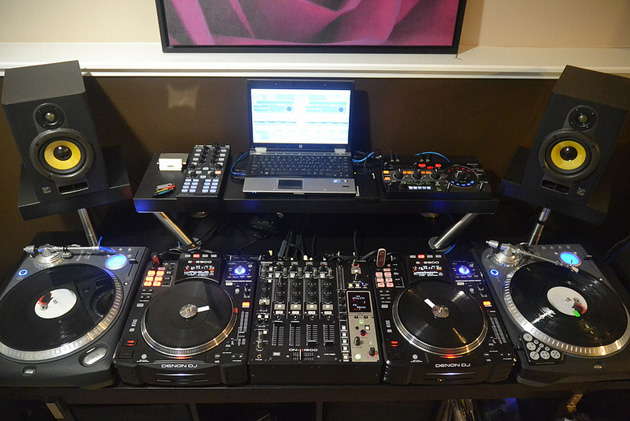 Discussions concerning the future of electronic dance music typically cover two aspects: DJing technology and how to promote it. Up-to-date social media knowledge, really, defines the former, while the latter, as we saw back at the 2013 Winter Music Conference, has evolved beyond the turntable-versus-laptop debate to the sounds the DJ creates.
Discussions concerning the future of electronic dance music typically cover two aspects: DJing technology and how to promote it. Up-to-date social media knowledge, really, defines the former, while the latter, as we saw back at the 2013 Winter Music Conference, has evolved beyond the turntable-versus-laptop debate to the sounds the DJ creates.
Yet, production has assumed such a great role that DJs can no longer solely exist as guys who put together the perfectly-entertaining tracklists. Instead, a hit propels him to the top gigs, leading to the phenomenon of ghost production that we touched on last month.
However, you know electronic dance music is in trouble when Steve Angello starts bemoaning its lack of creativity. “I think it’s really important for dance music today to become creative again,” Angello told MTV recently. “Rethink and not just repeat yourself over and over again, like a lot of producers do.”
In many senses, the now-defunct Swedish House Mafia is to electronic music as Nickelback was to grunge: the major corporate force that snuffed out any and all forms of innovation. Even if grunge could be boiled down to recycled punk with some heavy metal thrown in, its energy and slapdash attitude superseded the heavily-produced hair metal of the late 1980s; Nickelback’s calculated approach, of grunge repackaged for stadiums and glossy album covers, may have incorporated Nirvana’s guitars, but it was nothing more than a hair metal aesthetic with a new façade.
Nickelback, as well as equally noisome contemporaries like Creed, killed rock music, although, at the time, much of the blame was placed on quickly-burgeoning and manufactured pop acts like the Spice Girls,*NSYNC, and Britney Spears. Since then, any sounds falling with rock’s approach can best be describes as retro: be it the new-punk of the early aughts, The Killers doing a good Duran Duran impression, or The Strokes making a career out of 1970s garage.
 While the rise of EDM around 2010 might have been the genre’s demise, or, at best, indication it hit a plateau, this old-but-new approach characterizes electronic music, from producer discussions at the Winter Music Conference to Nile Rodger’s description of Daft Punk’s Random Access Memories: “It’s like they went back to go forward.”
While the rise of EDM around 2010 might have been the genre’s demise, or, at best, indication it hit a plateau, this old-but-new approach characterizes electronic music, from producer discussions at the Winter Music Conference to Nile Rodger’s description of Daft Punk’s Random Access Memories: “It’s like they went back to go forward.”
Yet, the whole irony in statements like Angello’s and Rodger’s is, a futuristic sound defined the genre since its beginning. “If we reflect on past and present movements in the styles of electronic music, we see that it has always been about the future and futurism,” Dan Petrovic wrote in Analogik in 2010. Could the present be the first instance electronic music is not forward thinking?
If rock’s creative demise (keep in mind that artists still pull in record and tour figures many electronic performers can only dream of having) foreshadows what could be EDM’s imminent future, it’s this: a decade of recycled retro trends with no single creative force that unifies listeners.
The Turnkey Approach
A term frequently applied to manufacturing, “turnkey” showed up in a rare interview Daft Punk’s Thomas Bangalter did recently with Billboard. “The problem with the way to make music today, these are turnkey systems; they come with preset banks and sounds,” Bangalter said. “They’re not inviting you to challenge the systems themselves, or giving you the ability to showcase your personality, individuality. They’re making it as if it’s somehow easier to make the same music you hear on the radio. Then it creates a very vicious cycle: How can you challenge that when the system and the media are not challenging it in the first place?”
 While “Get Lucky” might be a fresh breath of air after many interchangeable EDM singles, the track doesn’t necessarily push the envelope. But while “turnkey” is essential for producing any product in a manufacturing facility, as otherwise production and time-to-market are excruciatingly long, it’s a term that should describe no musical genre.
While “Get Lucky” might be a fresh breath of air after many interchangeable EDM singles, the track doesn’t necessarily push the envelope. But while “turnkey” is essential for producing any product in a manufacturing facility, as otherwise production and time-to-market are excruciatingly long, it’s a term that should describe no musical genre.
The uniformity doesn’t just extend to sounds, of most artists who moderately rise and then quickly burn out, but to live shows. Top festivals like Ultra and Electric Daisy Carnival have the same burn and turn approach with sets – and artists, as a result, give only a brief glimpse of their individuality. “Dance music is so interchangeable,” Diplo told the Huffington Post. “There’s not a lot of face to it. It’s a bunch of Dutch DJs with the same haircut. You go see a dance stage at a f-cking dance festival and I’m bored out of my f-cking mind. That’s not going to last very much longer, because kids see that it’s the same sh-t every single time.”
One issue may be the whole melting-pot approach of modern producers; there’s no defined house or trance, and even newer subgenre is assuming some of these characteristics. As a testament to what’s troubling about this modern approach is Skrillex’s Rolling Stone interview last year. “Electronic dance music can be so many things,” the producer born Sonny Moore said. “If you can dance to it, and it’s produced electronically, I guess it could be anything in the future.”
Originality? Ha.
As much as Diplo, Daft Punk, and Steve Angello, as well as plenty of DJs and producers before them, call modern electronic music the genre’s nadir, fans and other producers aren’t receptive when a high-profile artist does something different.
Take Avicii’s second set at the 2013 Ultra Music Festival. The New York Times reported it “resembled a Nashville concert than a performance by one of the stars of electronic dance music.”
During his hour on stage, the Swedish producer started off with his hits, including “Levels” and “I Could Be The One,” but quickly transitioned to a “live” set with bluegrass and country artists Mac Davis, Audra Mae, Dan Tyminski, and Aloe Blacc and three members of Incubus. While the rockers provided instrumentation, the rest provided vocals, with Mae shifting over to kazoo at one point, and Avicii mixed.
On the Ultra main stage, shifting over to country is a major risk, one which Avicii intentionally took to showcase his upcoming debut album. About his decision, he told the press: “This is the most interesting time for electronic music right now, because it has never been this big before.”
 Within the social media sphere, reactions were extremely divisive, as InTheMix.com pointed out. While Zedd and Morgan Page were receptive, Tiga described it as a “Rednexx revival,” El Hornet called Avicii a “troll,” and Kill The Noise compared him to “Al Walser” – perhaps the worst industry-specific insult if there ever was one.
Within the social media sphere, reactions were extremely divisive, as InTheMix.com pointed out. While Zedd and Morgan Page were receptive, Tiga described it as a “Rednexx revival,” El Hornet called Avicii a “troll,” and Kill The Noise compared him to “Al Walser” – perhaps the worst industry-specific insult if there ever was one.
Bad Eurodance comparisons aside, trying something new has potential to be met with hostility by other producers. While innovations may bubble below the surface in the underground (keep in mind, dubstep artist Zection did a countrified EDM track, “Redneck Vanilla,” earlier in 2013 that wasn’t met with the same level of vitriol that Avicii’s Ultra set received), the mainstream sphere is less receptive. It’s as if this particular incident, regardless of how you feel about Avicii and his music, tells other producers: Be innovative, but only the right kind of innovative.
Go Back to Go Forward
As much as Rodgers praises Daft Punk for their nouveau-retro sound (it’s new-ish disco but not nu-disco), the French duo is a mainstream manifestation of one concern expressed at the 2013 Winter Music Conference: That older sounds from ‘80s-era synths and drum machines are coming back, but the digital quality removes the depth and soul. At the time, Murk’s Ralph Falcon stated during panel “Future Retro: Shades of House & EDM”: “The sound quality is vastly superior to anything you’ll have on Logic, Pro Tools.”
So, in an attempt to do something different, Daft Punk, revealed in Bangalter’s Billboard interview, went retro with their recording technology, spending time at New York studio Electric Lady and using real instruments. “The idea was really having this desire for live drums, as well as questioning, really, why and what is the magic in samples?” Bangalter said. “Why for the last 20 years have producers and musicians been extracting these little snippets of audio from vinyl records? What kind of magic did it contain?”
But electronic music doesn’t have to be either-or, fully organic or all digital. As much as Bangalter is attempting to brand Daft Punk’s analog-sounding, instrumental record as the savior to modern electronic music, he seems to forget that his predecessors, specifically Depeche Mode and New Order, brought together these elements and successfully incorporated sampling. Maybe for their next record, Daft Punk should consider giving New Order’s Low-Life a re-listen.
Never Trust Pop Music
If hip-hop was eventually accepted by major record labels, could EDM get the same reception? Already, major electronic producers like Zedd are being snatched up by major labels, while Columbia, with Daft Punk and Depeche Mode newly on its roster, is attempting to position itself as a mainstream electronic music powerhouse.
 While the French duo and David Gahan and Co. have a couple decades of experience, and essentially prove to provide Columbia a return on its investment, newer producers are considered a greater gamble. That’s likely why multiple panelists emphasized full career management and control at the 2013 Winter Music Conference, and practically all producers have their own labels.
While the French duo and David Gahan and Co. have a couple decades of experience, and essentially prove to provide Columbia a return on its investment, newer producers are considered a greater gamble. That’s likely why multiple panelists emphasized full career management and control at the 2013 Winter Music Conference, and practically all producers have their own labels.
But while getting on a well-known label might have been a ticket over a decade ago, pop music seems to be stabbing EDM in the back. Will.i.am borrowed nearly an entire track from Arty and Mat Zo without providing proper credit, and Diplo, a fairly successful label manager in his own right, got majorly burned by Interscope.
“Interscope dropped Major Lazer when we asked for money for a video for ‘Get Free,’ and we sold 150,000 copies of that song,” he explained in his Huffington Post interview. “So that just proves that labels have no idea what’s going on anymore. They just want to jump on EDM d-ck – sh-t that sucks because they don’t feel the music but think it’s happening”




